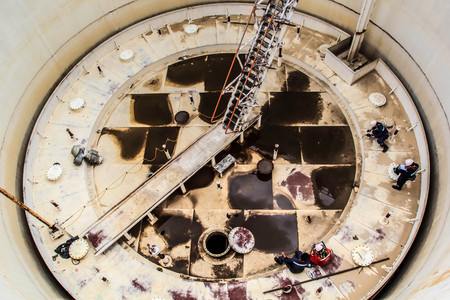Storage Tanks Floating Roofs – Challenges In Aging Tanks When Exposed To Extreme Weather Conditions

Over one hundred thousand floating roofs have been used in hydrocarbon (oil) storage tanks since the 1950s. A majority of these tanks continue to be in service and are critical to meet strategic storage needs. An earlier article in this blog category describes Industry Best Practices for inspection and maintenance of such tanks. View Maintenance & Reliability of Floating Roofs.
The article below responds to multiple inquiries – from domestic and international refiners – who are confronted with challenges to safely operate and maintain large diameter (200-350 feet diameter) floating roofs in service for 30-35 years. In addition to age, these tanks may be exposed to extreme weather conditions such as hurricane winds above 100 mph and/or excessive rainfall. For example, Hurricane Harvey dumped in excess of 50 inches of rain in the Houston, TX area with sustained winds of 130 mph in 2017.
Under these extreme conditions, catastrophic damage to floating roofs may occur. Your operation may be faced with roof sinking (with substantial repair costs in the $ 1MM-2MM range) and the resultant loss of storage capacity. An understanding of the vulnerability factors for such tanks along with opportunities for potential risk mitigation are described below. In general, the older roofs are not designed to cope with excessive corrosion damage and extreme weather conditions. Single deck pontoon type roofs and roofs with distributed buoyancy are more vulnerable than double deck roofs and radially stiffened design. It is important to note that most roof incidents over the past 30 years occurred with single deck pontoon designs.
Floating Roof Screening Considerations for Further Evaluation
The following considerations may be used to screen existing single deck pontoon-type roofs:
- Roofs which were not designed to API Standard 650 and relied on vendor know-how; and
- Roofs which were designed to API Standard 650 buoyancy considerations but did not include safety margins for buckling resistance of the pontoon structure.
Floating Roof Structural Vulnerability Factors
The following failure modes and damage mechanisms contribute to roof damage and sinking:
- Corrosion damage in the roof center deck membrane and pontoon plates;
- Fatigue cracking of fillet welds in deck plates and attachment welds at roof supports;
- Wind-induced rippling damage at fillet welds in the center deck membrane;
- Foam dam buckling and corrosion in the pontoon plates;
- Guide Pole corrosion resulting in loss of anti-rotation protection;
- Rolling ladders which prevent roof flotation and cause submergence;
- Failure of check valves in the roof sump causing oil pooling on to the center deck; and
- Excessive differential settlement of the tank leading to roof seal damage and binding.
Floating Roof Vulnerability – Good Practices to Avoid Failure
Floating roofs function as seals to minimize hydrocarbon vapors from open top tanks. Reserve buoyancy for the roof is provided with leak tight pontoon compartments. Their flotation is contingent upon rainwater being drained effectively by roof drains. Safe operation of roofs is dependent practices which cope with aging and extreme weather conditions. Examples of good practices follow:
- Prevent accumulation of rain water through adequate drainage practices;
- Monitor the roof center deck, on a planned basis, for evidence of ponding;
- Periodically inspect roof welds for oil stains and onset of oil seepage;
- Assess Operating Practices that prevent uncontrolled roof landings during tank filling and draining;
- Inspect pontoon compartments for oil seepage;
- In extreme weather conditions, assess wind-induced rippling damage on the roof membrane; and
- Periodically monitor roof travel and evidence of instability such as roof tilting.
Proactive Condition Assessment and Risk Management for Aging Tanks
Current practices in industry rely on planned inspection and maintenance of floating roofs. Some of these practices utilize guidance provided in API Standard 653. None of these practices recognize the vulnerability factors in aged tanks and recognition of extreme weather conditions. The management practices for major roof incidents by refiners today are primarily reactive. These practices are devoid of pro-active strategies which should identify roofs “at risk” and implement risk reduction measures in place.
In addressing the above concern with large diameter single deck floating roofs, it is suggested that tank operators develop Risk Reduction Plans (RRP), for individual roofs using qualitative criteria such as the following:
- Service life of the tank. (Age Factor);
- Roof design basis and Industry Standard (Buckling Resistance);
- Inspection and corrosion history for the roof components;
- Location of the tank and its exposure to extreme weather conditions;
- Meteorological data for the tank site, including predicted wind loads and rainfall;
- Roof drainage capacity to cope with extreme weather conditions;
- Operating logs to determine whether there has been a history of uncontrolled landings;
- A Risk Matrix (Probability & Consequence) to determine the current operating risk levels;
Where the current risk is deemed to be intolerable, develop risk reduction measures for use with the tank in service. Using the above approach, the operator should develop a “risk ranking” profile for large diameter floating roofs in the tank farm.
Becht Engineering has proprietary software tools and a team of Multi-Disciplinary Senior Tank Specialists, and TA Planning / Execution resource. These Specialists can assist clients in the development and implementation of Storage Tank Maintenance Programs, including Risk Assessments of Existing Storage Tank Operations where needed.
Have a question or would like more information? You may post to this blog or click the link below for more help.
Contact Becht Reliability Services
or Call Arcot (“Radha”) Radhakrishnan at
(949) 208-6882




